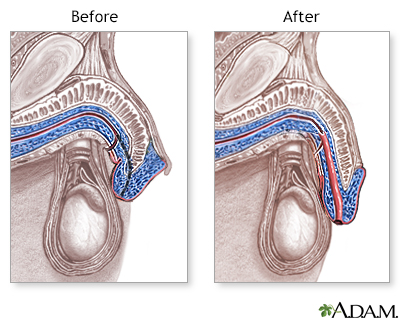Hypospadias repair - discharge
Your child had hypospadias repair to fix a birth defect in which the urethra does not end at the tip of the penis. The urethra is the tube that carries urine from the bladder to outside the body. The type of repair that was done depends on how severe the birth defect was. This may be the first surgery for this problem or it may be a follow-up procedure.
Hypospadias repair
Hypospadias repair is surgery to correct a defect in the opening of the penis that is present at birth. The urethra (the tube that carries urine ...

Penis
The penis is the male organ used for urination and sexual intercourse. The penis is located above the scrotum. It is made of spongy tissue and bloo...

Your child received general anesthesia before surgery to make him unconscious and unable to feel pain.
What to Expect at Home
Your child may feel sleepy when first at home. He may not feel like eating or drinking. He may also feel sick to his stomach or throw up the same day he had surgery.
Your child's penis will be swollen and bruised. This will get better after a few weeks. Full healing will take up to 6 weeks.
Your child may need a urinary catheter for 5 to 14 days after the surgery.
- The catheter may be held in place with small stitches. The health care provider will remove the stitches when your child does not need the catheter anymore.
- The catheter will drain into your child's diaper or a bag taped to his leg. Some urine may leak around the catheter when he urinates. There may also be a spot or two of blood. This is normal.
If your child has a catheter, he may have bladder spasms. These may hurt, but they are not harmful. If a catheter has not been put in, urinating may be uncomfortable the first day or two after surgery.
Your child's provider may prescribe some medicines:
- Antibiotics to prevent infection.
- Medicines to relax the bladder and stop bladder spasms. These may cause your child's mouth to feel dry.
- Prescription pain medicine, if needed. You can also give your child acetaminophen (Tylenol) for pain.
Taking Care of Your Child
Your child may eat a normal diet. Make sure he drinks plenty of fluids. Fluids help keep the urine clean.
A dressing with a clear plastic covering will be wrapped around the penis.
- If stool gets on the outside of the dressing, clean it gently with soapy water. Be sure to wipe away from the penis. Do not scrub.
- Give your child sponge baths until the dressing is off. When you do start bathing your son, use only warm water. Do not scrub. Gently pat him dry afterwards.
Some oozing from the penis is normal. You may see some spotting on the dressings, diaper, or underpants. If your child is still in diapers, ask your provider about how to use two diapers instead of one.
Do not use powders or ointments anywhere in the area before asking your child's provider if it is OK.
Your child's surgeon will probably ask you to take off the dressing after 2 or 3 days and leave it off. You may do this during a bath. Be very careful not to pull on the urinary catheter. You will need to change the dressing before this if:
- The dressing rolls down and is tight around the penis.
- No urine has passed through the catheter for 4 hours.
- Stool gets underneath the dressing (not just on top of it).
Infants may do most of their normal activities except for swimming or playing in a sandbox. It is fine to take your baby for walks in the stroller.
Older boys should avoid contact sports, riding bicycles, straddling any toys, or wrestling for 3 weeks. It is a good idea to keep your child home from preschool or daycare the first week after his surgery.
When to Call the Doctor
Contact the provider if your child has:
- Persistent low-grade fever or fever over 101°F (38.3°C) in the week after surgery.
Fever
Fever is the temporary increase in the body's temperature in response to a disease or illness. A child has a fever when the temperature is at or abov...
 ImageRead Article Now Book Mark Article
ImageRead Article Now Book Mark Article - Increased swelling, pain, drainage, or bleeding from the wound.
- Trouble urinating.
Trouble urinating
Painful urination is any pain, discomfort, or burning sensation when passing urine.
 ImageRead Article Now Book Mark Article
ImageRead Article Now Book Mark Article - A lot of urine leakage around the catheter. This means the tube is blocked.
Also contact the provider if:
- Your child has thrown up more than 3 times and cannot keep fluid down.
- The stitches holding the catheter come out.
- The diaper is dry when it is time to change it.
- You have any concerns about your child's condition.
References
Long CJ, Zaontz MR, Canning DA. Hypospadias. In: Partin AW, Dmochowski RR, Kavoussi LR, Peters CA, eds. Campbell-Walsh-Wein Urology. 12th ed. Philadelphia, PA: Elsevier; 2021:chap 45.
Thomas JC, Brock JW. Repair of proximal hypospadias. In: Smith JA, Howards SS, Preminger GM, Dmochowski RR, eds. Hinman's Atlas of Urologic Surgery. 4th ed. Philadelphia, PA: Elsevier; 2018:chap 130.
Hypospadias - illustration
Hypospadias is a relatively common abnormality of the penis that appears as an abnormal opening of the penis (meatus) on the under side of the penis rather than at the end.
Hypospadias
illustration
Hypospadias repair - series
Presentation
Review Date: 1/1/2025
Reviewed By: Kelly L. Stratton, MD, FACS, Associate Professor, Department of Urology, University of Oklahoma Health Sciences Center, Oklahoma City, OK. Also reviewed by David C. Dugdale, MD, Medical Director, Brenda Conaway, Editorial Director, and the A.D.A.M. Editorial team.







